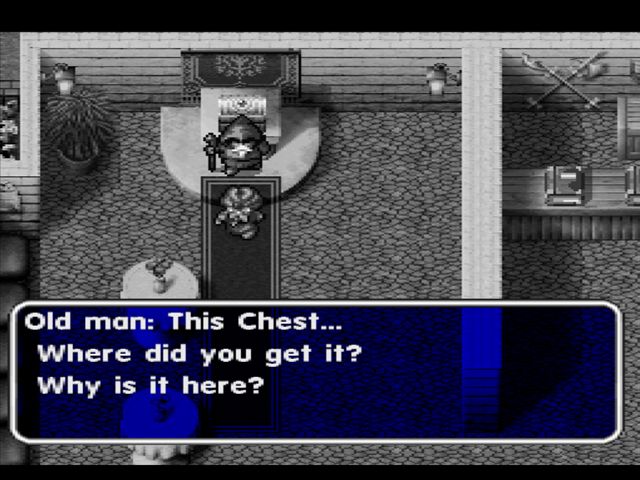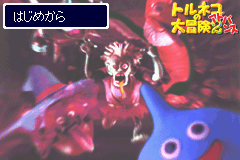Retro Replay Review
Gameplay
World of Dragon Warrior: Torneko – The Last Hope builds upon the beloved Fushigi no Dungeon formula with a blend of classic roguelike mechanics and town-building elements. Each expedition sees Torneko descend into a series of randomly generated dungeons viewed from an overhead perspective. Despite the fluid animations and free movement, every step, swing of the sword, and use of a potion operates on a turn-based system: your action immediately triggers a reaction from nearby monsters, creating a careful dance of strategy and risk assessment.
(HEY YOU!! We hope you enjoy! We try not to run ads. So basically, this is a very expensive hobby running this site. Please consider joining us for updates, forums, and more. Network w/ us to make some cash or friends while retro gaming, and you can win some free retro games for posting. Okay, carry on 👍)
Item management lies at the heart of the experience. Torneko’s hunger meter forces players to hunt for herbs, fruits, and prepared dishes to stave off starvation, while magic scrolls, staves, and equipment can be found, used, or sold. The tension of inventory space comes alive when you must decide between carrying healing items for safety or hoarding treasure to sell in town. Moreover, death has real consequences: should Torneko perish, he leaves the dungeon empty-handed, though he can store a handful of items in the village’s vault, preserving some of his hard-earned loot for future runs.
Outside the dungeons, a light town-building simulation provides an engaging meta-progression loop. As Torneko returns with riches, he can invest in new shops and services—such as a blacksmith, baker, or witch—to expand the village’s offerings. These additions not only make future dungeon runs more manageable (through access to better equipment or healing items) but also inject personality and charm into the hub area, making each return home feel rewarding beyond the experience gained or gold collected.
Graphics
Graphically, Torneko – The Last Hope strikes a balance between colorful character sprites and detailed dungeon environments. The overhead view is rendered with crisp, anime-inspired designs that capture the friendly yet rugged personality of Torneko himself. Each monster—from slimes and skeletons to more exotic foes—has distinct animations that make combat feel lively, even within the confines of a grid-based layout.
The dungeon aesthetics vary from mossy caves and lava-filled caverns to ethereal chambers suffused with magic. Lighting effects, such as glowing crystals and torch flickers, create atmosphere and help convey the sense of exploring unknown depths. While the visuals are not cutting-edge by modern standards, they are cleanly executed, and the consistent art direction ensures every area feels part of a cohesive world.
On the village side, the incremental growth of buildings and the colorful outfits of townsfolk lend a warm, inviting vibe. Watching the hamlet expand from a humble settlement into a bustling trading post is rendered in simple but effective 2D backgrounds and character portraits. Occasional cutscenes, enhanced by character artwork and subtle animations, underscore key story moments without interrupting gameplay flow.
Story
Picking up after the events of the original Fushigi no Dungeon, Torneko has enjoyed newfound wealth and peace in his fishing village. The “Joy Chest,” the ultimate treasure from his previous adventure, sits proudly in his shop—only to attract the attention of a mysterious stranger. This stranger’s arrival coincides with an ominous phenomenon: monsters re-emerge, and swathes of the kingdom are swallowed by spontaneous, otherworldly dungeons.
The narrative unfolds through conversations with the king, town NPCs, and the enigmatic visitor, providing a steady drip of lore about the origins of these bizarre portals. While the plot remains light in tone—befitting the affable, middle-aged merchant hero—it still provides enough intrigue to drive each dungeon crawl. Torneko’s playful banter and merchant-minded observations ground the story in charm, even as the stakes rise.
Side quests and town requests further enrich the tale. Villagers ask Torneko to retrieve specific items or rescue lost pets, tying the dungeon experiments back to the community he’s grown to care for. These small narrative flourishes reinforce your role not just as an adventurer, but as a pillar of the town, giving greater meaning to every delve into darkness.
Overall Experience
World of Dragon Warrior: Torneko – The Last Hope offers a compelling mix of roguelike challenge and town-management gratification. Its turn-based combat, resource management, and procedural level design create endless variety, ensuring no two journeys feel identical. The persistence of the village hub and the satisfaction of watching shops and services flourish deliver a strong sense of progression, even when Torneko faces repeated failures in the dungeon.
While the learning curve can be steep for newcomers to the Mystery Dungeon series, patient players will discover a deeply rewarding loop: delve, gather, survive, return, invest, and repeat. The balance between risk and reward is finely tuned, with the right mix of tension during explorations and relief upon escape. Even mid-run, you’ll find yourself calculating whether to push one floor deeper or cut losses and head back to town.
Ultimately, Torneko’s latest outing is a must-play for fans of roguelikes and Dragon Warrior lore. Its approachable yet strategic gameplay, charming visuals, and earnest storyline come together in an adventure that feels both nostalgic and refreshingly robust. For anyone seeking a dungeon crawler with real staying power and character, Torneko: The Last Hope delivers on every front.
 Retro Replay Retro Replay gaming reviews, news, emulation, geek stuff and more!
Retro Replay Retro Replay gaming reviews, news, emulation, geek stuff and more!









Reviews
There are no reviews yet.